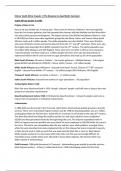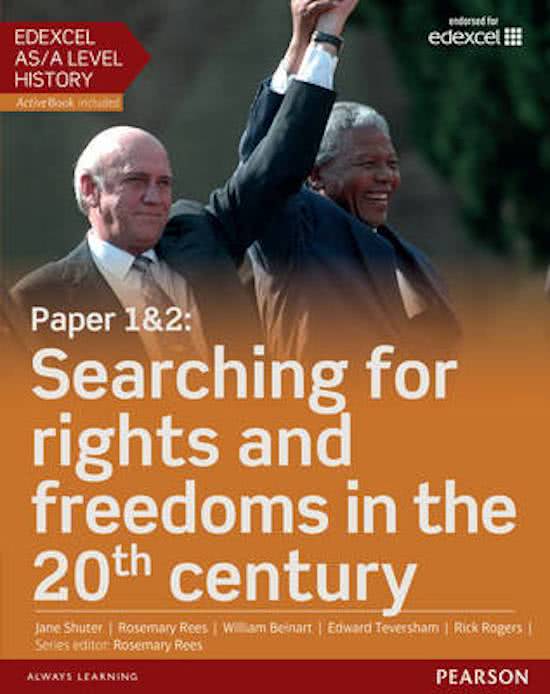History South Africa: Enquiry 1 (The Response to Apartheid): Summary:
South African Society in 1948:
Origins of Race in SA:
Race in SA was divided into 4 main groups. There were the Africans (‘Natives’) who had originally
been the San hunter-gatherers but had expanded into farmers with the Khoikhoi and had diversified
into many ethnic groups and kingdoms. The largest was the Zulu (British had defeated them in a war
in 1878-85) but there were other significant groups like the Xhosa, Sotho, and Tswana. Black South
Africans made up 8.5 million people. The white population was also divided. There were the Boer
who were off Dutch, French and German descent (from the 17 th and 18th centuries). There were also
the English who descended from British colonists from the 19 th century. The white population was
2.6 million (60% Afrikaans and 40% English). Those who were not white or African were classed as
‘coloured people’ and they made up 1.1 million people but there were also the descendants of
indentured Indians who’d come to work on sugar plantations and made up 3% of the population.
Black South Africans: Africans or ‘Natives’ - San hunter gatherers – Khoikhoi farmers – Zulu largest
group (British had defeated in 1878-85) – Xhosa, Sotho, Tswana – 8.5 million people
White South Africans: Boer/Afrikaners - descend from Dutch, French, German 17 th/18th centuries –
English – descend from British 19th century – 2.6 million people (60% Afrikaans, 40% English)
‘Coloured’ South Africans: not white or African – 1.1 million people
Indian South Africans: descend from workers in sugar plantations – 3% population
Voting Rights Before 1948:
Black SAs were disenfranchised in 1936, though ‘coloured’ people could still vote as long as they met
property or education requirements.
Disenfranchisement before 1948: 1936 black SAs disenfranchised - ‘coloured’ people could vote as
long as they met property or education requirements
Urbanisation:
In 1886 gold was discovered in the Transvaal, which led to Johannesburg quickly growing to provide
services. There were many black migrant workers and by 1948 the black population was at 1 million,
outstripping whites for the first time. South Africa’s economy ran off of gold in the early 20 th century.
This then diversified into things like textiles and the iron and steel industries were established
(ISCOR) and they generated electricity through things like coal. This industry expanded further in
WW2 as imports were not possible and more black SAs were employed as 180,000 white SAs were in
the army. This led to vast competition after the war and the ‘poor white problem’ emerged. Many
white SAs were absorbed into state employment like on the railways but many remained in poverty
as they did not want to take up work that was supervised by black SAs or seen as ‘black labour’.
White people wanted to try and create white-only cities, but this was increasingly difficult. So,
townships (areas outside cities) were allocated to house black migrants, like Soweto which was
20km outside of Johannesburg.
Gold Economy: 1886 gold discovered in Transvaal – Johannesburg grew quickly to provide services –
black migrant workers – Jo'burg 1 million black SAs in 1948 (outstripping whites for first time)
,Diversified Economy: early 20th century gold – more expansion into things like textiles – iron and
steel industries established (ISCOR) - industry expanded further in WW2 as imports were not
possible
Poor White Problem: many black SAs employed in WW2 as 180,000 white SAs in army – competition
after WW2 - ‘poor white problem’ - many in state employment like railways – still many poor as
didn’t want to take up jobs supervised by black SAs or seen as ‘black labour’
Townships: wanted to have white cities but not possible with migration – townships allocated to
house black migrants – Soweto 20km outside of Joburg
Rural Life:
In rural areas, white people owned 80% and many black people worked as wage labourers and
tenants on their land. They were able to keep a strict social hierarchy in which white SAs had
‘baasskap’ (bosshood). It was black people who did the manual labour in the economies based on
maize, sugar, grapes and merino wool. Many black people in rural areas either lived as tenants or on
reserves. These reserves were traditionally poor and had peasant economies but were changing.
Missionaries established Christianity and set up mission schools. Taxation forced reserves into the
cash economy and people started wearing more Western clothes or traditional clothes made of
imported fabric. Men were more working in cities and women were the lynchpin of the rural
community. Though they stayed very poor.
Rural Land Ownership: white SAs owned 80% of land – black people worked as wage labourers or
tenants – strict social hierarchy – white SAs had ‘baasskap’ (bosshood)
Economies: black people did the manual labour – economies based on maize, sugar, grapes, merino
wool
Reserves: black people either tenants or lived on reserves – poor and had mainly peasant economies
Changing Reserves: missionaries brought Christianity and schools – taxation meant cash economy
(more Western clothes or traditional clothes made of imported fabric) - men working in cities and
women lynchpins of rural community
Afrikaner Culture:
The 2nd Boer War (1899-1902) had left a bitter legacy. In 1910, when SA got self-governance from
Britain, Smuts had attempted to unite the white population. However, in 1913 Hertzog founded the
Afrikaner National Party, which won power in 1824 and introduced things like bilingualism in
national civil service and Afrikaans as national language not Dutch. The depression forced the parties
together and the United Party was founded in 1934. However, Malan split off to reform the National
Party. In the 1920s and 30s there was growing Afrikaner pride, there was the 1938 centenary of the
Great Trek and new communities were emerging in towns with Afrikaans-speaking suburbs. They
could easily be appealed to by politicians.
Boer War: 2nd Boer War (1899-1902) left bitter legacy
Changing Afrikaner Politics: 1910 Smuts tries to unite – Hertzog founds Afrikaner National Party in
1913 – wins power in 1824 – bilingualism in national civil service and Afrikaans as national language
not Dutch – depression forced together – United Party formed in 1934 – Malan splits off to reform
the National Party
,Afrikaner Pride: Afrikaner pride growing in 1920s and 30s – 1938 centenary of the Great Trek – new
communities with Afrikaans-speaking suburbs in towns
Influence of Britain:
In 1910, SA got self-governance as part of the British empire. Britain still had a lot of influence – the
parliamentary system was used, 40% of the white population were of British descent, there were
many British investors, English was the joint official language, there were English sports like cricket.
They joined with Britain in WW2.
Self-Governance: SA got self-governance as part of British empire in 1910
British Influence: 40% population – British investors in mining/industry - English joint official
language – English sports like cricket – joined with Britain in WW2
Why did the National Party win in 1948?
The Political System:
Malan was able to win with only 38% of the vote (Smuts got 49%) but due to the parliamentary
system he was able to command a majority of seats and so took power. This was due to him winning
many smaller rural constituencies – though only marginally.
Constituency System: Malan got 38% and Smuts got 49% - Malan won smaller rural constituencies –
though only marginally
War:
War led to a lot of black employment and a fear of black peril – there was anger about white
poverty. There was also anger about siding with Britain – especially from Afrikaners.
War: ‘poor white problem’ - Afrikaner anger at siding with Britain
International Context:
Human rights became more a concern after WW2 and there was decolonisation starting with the
independence of India in 1947. There was still some support in places like America, with the Jim
Crow Laws – they were able to paint the image of segregation as Christian, Western, anti-
communist.
International Context: human rights more of an issue – decolonisation after independence of India
in 1947 – still support like Jim Crow Laws – able to paint image of segregation as Western, Christian,
Anti-Communist
Afrikaner Nationalism:
From 1939, the idea of the Afrikaners as a ‘volk’ gained political currency. The Broederbond were an
organisation dedicated to the advancement of Afrikaners economically (Economic Movement) as
well as politically and culturally. The Dutch Reformed Churches were Calvinist churches that
preached that white and black people living separately was God’s plan, criticising things like inter-
marriage. This was fuelled by supporting Britain in WW2, the Ossewabrandwag had 300,000
members and was a nazi-sympathising anti-war movement who held mass rallies in the war and
joined the National Party after it. Afrikaner Nationalism was routed in history but also a recent
struggle, with ¾ of urban Afrikaners working class after WW2.
, Growth of Afrikaner Nationalism: ‘volk’ idea gained political currency after 1939 – anger at joining
British – ¾ urban Afrikaners working class after WW2
Broederbond: Broederbond were an organisation dedicated to advancement of Afrikaners –
economically (Economic Movement), politically, culturally
Dutch Reformed Church: Dutch Reformed Churches – Calvinist – preached white and black people
living separately was God’s plan – criticising inter-marriage
Nazi Sympathisers: Ossewabrandwag 300,000 members – Nazi sympathisers – anti-war movement –
mass rallies – joined NP after
White Supremacy:
WW2 caused a rise in language like ‘black peril’ and ‘swamping’ as cities had more black SAs
(Johannesburg 1 million in 1948 – outstripping whites first time) and black SAs saw economic
advancement (WW2 black wages rose from 1/5 of white to ¼). Migration led to competition in cities
but also a lack of black labour for white farmers.
WW2 White Supremacy: ‘black peril’ and ‘swamping’ - 1948 1 million black SAs in Joburg – black SA
wages WW2 1/5 of white to ¼
Widespread White Supremacy: competition in cities – also lack of black labour for white farmers
Weakness of Opposition:
Malan was able to appeal as an anti-imperialist, attacking the enemies of Britain, mining capital, and
Smuts. This was because Smuts was a pragmatist, whilst he was not a liberal, he was adopting more
liberal policies and more pragmatic ideas (if industry needed more black workers, he would facilitate
this). This meant that his minister of health advocated for more national health services for white
and black people (in segregated hospitals). Smuts also used the police to crush a miner’s strike in
1946 which killed 6 and injured 400 and allowed black trade unions. Smuts had a lot of hubris and
wasn’t noticing people turn away from him so didn’t change.
Malan Appeal: anti-imperialist – attacking enemies of Britain, mining capital, Smuts
Smuts Lack of Appeal: pragmatist (if industry needed more black workers, he would facilitate) -
more liberal ideas starting in his government (not him)
Smut’s Pragmatism: used police to crush a miner’s strike in 1946 – killed 6 and injured 400 – allowed
black trade unions
Smut’s Liberal: Minister of Health advocated for more national health services – black and white but
in segregated hospitals
Smut’s Hubris: hubris – didn't change
Codification and Implementation of Apartheid:
Political Strengthening:
The National Party needed to secure their political power, in order to actually execute apartheid. In
1949 they added 6 MPs in Namibia, where there was more Nationalist support, as Namibia was ruled
by mandate under the UN. The National Party also made efforts to disenfranchise ‘coloured’ people.
They passed the 1951 Separate Representation of Voters Act but did not get 2/3 in parliament so
had to appoint new Afrikaner judges to get it through the courts. They also took power in the





